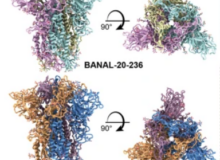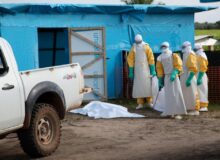by Jonathan Latham, PhD
Professor Pamela Ronald is probably the scientist most widely known for publicly defending genetically engineered (GE or GMO) crops. Her media persona, familiar to readers of the Boston Globe, the Wall Street Journal, the Economist, NPR, and many other global media outlets, is to take no prisoners.
After New York Times chief food writer Mark Bittman advocated GMO labelling, she called him “a scourge on science” who “couches his nutty views in reasonable-sounding verbiage”. His opinions were “almost fact- and science-free” continued Ronald. In 2011 she claimed in an interview with the US Ambassador to New Zealand: “After 14 years of cultivation and a cumulative total of two billion acres planted, GE crops have not caused a single instance of harm to human health or the environment.”

This second career of Pamela Ronald’s, as advocate of GMOs (which also includes being a book author, and contributor to and board member of the blog Biofortified) is founded on her first career: at the University of California in Davis she is Professor in the Department of Plant Pathology, Director of the Laboratory for Crop Genetics Innovation, and Director of Grass Genetics at the Joint BioEnergy Institute, among other positions.
This background is relevant because Pamela Ronald is now also fighting on her home front. Her scientific research has become the central question in a controversy that may destroy both careers. In the last year Ronald’s laboratory at UC Davis has retracted two scientific papers (Lee et al. 2009 and Han et al 2011) and other researchers have raised questions about a third (Danna et al 2011). The two retracted papers form the core of her research programme into how rice plants detect specific bacterial pathogens (1).
When the mighty fall, others try to catch them
The first paper was retracted on January 29th 2013, from the journal PLoS One (Han et al 2011). News of the retraction was (belatedly) published on the 11th of September 2013 by the blog Retraction Watch under the headline: Doing the right thing: Researchers retract quorum sensing paper after public process (2). [CORRECTION: Jan 29th was the date the Ronald group notified PLoS One of probable errors. Retraction formally occurred on Sept 9th. Apologies to Retraction Watch as there was no delay to explain. Footnote 2 is therefore superfluous.]
The second retraction, from Science, was officially announced a month later, on October 11th 2013 (Lee et al 2009). This time, retraction was accompanied by a lengthy explanation (Anatomy of a Retraction, by Pamela Ronald) in the official blog of Scientific American. In this article, Ronald blamed the work of unnamed former lab members from Korea and Thailand. Retraction Watch reported the retraction as: Pamela Ronald does the right thing again. Also on the same day, The Scientist magazine quoted Pamela Ronald saying it was “just a mix-up” and repeating her claim that “Former lab members who had begun new positions as professors in Korea and Thailand were devastated to learn that [we] could not repeat their work.”
Scientifically, the two retractions mean that the molecule (Ax21), identified by Pamela Ronald’s group (in Lee et al 2009), is not after all what rice plants use to detect the pathogen rice blight (Xanthomonas oryzeae) and neither is it a ‘quorum sensing’ molecule, as described in Han et al 2011.
The media coverage of the retractions didn’t query Ronald’s mea non culpa. Instead, reports added, as UC Berkeley professor Jonathan Eisen put it, ‘Kudos to Pam’ for stepping forward.
Did Pamela Ronald jump, or was she pushed?
In fact, scientific doubts had been raised about Ronald-authored publications at least as far back as August 2012. In that month Ronald and co-authors responded in the scientific journal The Plant Cell to a critique from a German group. The German researchers had been unable to repeat Ronald’s discoveries in a third Ax21 paper (Danna et al 2011) and they suggested as a likely reason that her samples were contaminated (Mueller et al 2012).
Furthermore, the German paper also asserted that, for a theoretical reason (3), her group’s claims were inherently unlikely.
In conclusion, the German group wrote:
“While inadvertent contamination is a possible explanation, we cannot finally explain the obvious discrepancies to the results in..…..Danna et al. (2011)”
Pamela Ronald, however, did not concede any of the points raised by the German researchers and did not retract the Danna et al 2011 paper. Instead, she published a rebuttal (Danna et al 2012) (4).
The subsequent retractions, beginning in January 2013 (of Lee et al 2009 and Han et al 2011), however, confirm that in fact very sizable scientific errors were being made in the Ronald laboratory. But more importantly for the ‘Kudos to Pam’ story, it was not Pamela Ronald who initiated public discussion of the credibility of her research.
Was it “just a mix-up”?
Reporting of the retractions also accepted Pamela Ronald’s assertions that simple errors by two foreign and now-departed laboratory members were to blame. But her more detailed description of events, which appeared in Footnotes with technical details for those in the discipline below her Scientific American blog, contradict that notion.
Ronald’s footnotes admit two mislabellings, along with failures to establish and use replicable experimental conditions, and also minimally two failed complementation tests. Each mistake appears to have been compounded by a systemic failure to use basic experimental controls (5). Thus, leading up to the retractions were an assortment of practical errors, specific departures from standard scientific best practice, and lapses of judgement in failing to adequately question her labs’ unusual (and therefore newsworthy) results.
Who is responsible?
The International Committee of Medical Journal Editors (ICMJE ) published the first and most widely cited principles of authorial ethics in science. These recommendations are followed by thousands of medical and other scientific journals. The following is the first paragraph of the section regarding authorship:
“Authorship confers credit and has important academic, social, and financial implications. Authorship also implies responsibility and accountability for published work. The following recommendations are intended to ensure that contributors who have made substantive intellectual contributions to a paper are given credit as authors, but also that contributors credited as authors understand their role in taking responsibility and being accountable for what is published.” (italics added)
The ICMJE guidelines go on to state that authorship should not be conferred on those who do not agree to be accountable for all aspects of the accuracy and integrity of the work.
Some scientific journals, have their own policies that provide more specifics. The journal Arteriosclerosis, Thrombosis, and Vascular Biology states:
“Principal investigators are ultimately responsible for the integrity of their research data and, thus, every effort should be made to examine and question primary data.”
Likewise, Columbia University’s guidelines on responsible authorship and peer review concludes:
“Each author should have participated sufficiently in the work to take public responsibility for appropriate portions of the content.”
Lastly, Science (publisher of Ronald’s retracted Lee et al 2009 paper) has this policy on authorship:
“The senior author from each group is required to have examined the raw data their group has produced.”
It is perhaps surprising then that a senior scientist should publicly disclaim responsibility for research carried out in their own laboratory.
Footnotes
(1) Pamela Ronald appeared to be a leader in understanding the mechanisms by which rice, and other plants, detect and resist important pathogens. She and others have (or in the case of Ronald, thought they had) identified specific molecules characteristic of each pathogen that are detected by dedicated receptors in plants. In this case, rice cultivars resistant to the bacterium Xanthomonas oryzeae detect a small protein molecule called Ax21 that derives from the pathogen. The ability to detect Ax21 enables rapid activation of defences and thus confers resistance to the pathogen. This line of research, as it pertains to Pamela Ronald and Ax21, is now retracted.
(2) Retraction Watch does not explain the delay of over 8 months between the retraction and their report of it. Neither is the “after public process” part of the headline explained.
(3) The theoretical reason is that molecules that warn of incipient plant pathogen infection (as Ax21 was supposed to do) are typically detected by receptors at very low concentrations–otherwise they wouldn’t serve as useful warning molecules. Yet in the experiments from Pamela Ronald’s laboratory (Lee et al. 2009 and Danna et al. 2011) Ax21 is required to be present at concentrations millions of fold higher than other elicitors to achieve the same effects (Mueller et al 2012).
(4) The rebuttal argued, among other points, that: “experimental differences may explain the failure of Mueller et al. (2012) to observe FLS2-dependent defense-related responses.” (Danna et al 2012).
(5) The errors noted by Pamela Ronald in her Scientific American blog were: a) “By careful sleuthing, [lab members] found that two out of 12 of the strains……were mislabeled.” b)“In the more recent experiments we found that although the modified (sulfated) Ax21 peptide did induce resistance in Xa21 plants, it also induced resistance in plants lacking the Xa21 immune receptor, an important control.” c) “Furthermore, results of the pretreatment test were highly dependent on greenhouse conditions.” d) “They also made mistakes in their complementation tests of the Ax21 insertion mutant with the wild-type Ax21 gene.” (italics added). e) These errors were not caught prior to publication because experiments in the Ronald lab lacked controls. Apparently: “When laboratory members first established the pretreatment assay years ago, they included diverse controls to optimize the assays. However, in subsequent experiments, some of the controls were dropped to reduce the size of the experiments.”
References
Danna CH, YA Millet, T Koller et al (2011) The Arabidopsis flagellin receptor FLS2 mediates the perception of Xanthomonas Ax21 secreted peptides. PNAS 108: 9286-9291.
Danna CH, XC Zhang, A Khatri, AF Bent et al (2012) FLS2-mediated responses to Ax21-derived peptides: response to the Mueller et al. commentary Plant Cell 24:3174-3176.
Han SW, M Sriariyanun SW Lee, Sharma, O Bahar, Z Bower, PC. Ronald (2011) Small Protein-Mediated Quorum Sensing in a Gram-Negative Bacterium. PLoS One
Lee SW, SW Han, M Sririyanum, CJ Park, YS Seo et al. (2009) A type I secreted, sulfated peptide triggers XA21-mediated innate immunity Science 326: 850-853.
Mueller K., Chinchilla D., Albert M., Jehle A.K., Kalbacher H., Boller T., Felix G. (2012). The flagellin receptor FLS2 is blind to peptides derived from CLV3 or Ax21 but perceives traces of contaminating flg22. Plant Cell 24: 3193–3197.



